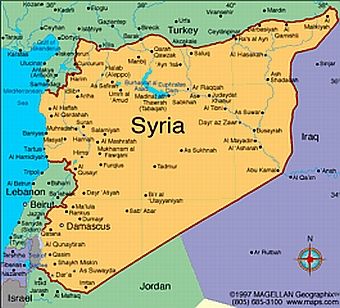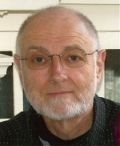
Publisher:
Bonnie King
CONTACT:
Newsroom@Salem-news.com
Advertising:
Adsales@Salem-news.com

~Truth~
~Justice~
~Peace~
TJP
Aug-19-2011 14:07

 TweetFollow @OregonNews
TweetFollow @OregonNews
Once Upon a Time in Syria
Ralph E. Stone Salem-News.comShould the House of Assad fall, I wonder what the resulting Syrian government's relations will be with Lebanon, Hezbollah, and Israel.
 Map of Syria |
(SALEM) - In 1999, we visited Syria as well as Jordan, Israel, and Baalbeck in Lebanon. We arrived in Syria on the eve of the Israeli elections. The majority of Arabs and Israelis probably agreed that the prospects for peace in the region improved immeasurably with the election of Ehud Barak as Israel's prime minister. Even our Syrian guide was cautiously optimistic. Our guide did note that Barak was a highly decorated war hero with the decorations earned at the expense of the Arabs. The deep animosities, however, were palpable. Looking back, peace was not to be.
While we were in Syria, Hafez al-Assad, a member of the Ba'ath Party, was president. He came to complete power in a bloodless intra-party coup in 1970 and held dictatorial power with a combination of ruthless suppression and guile.
During our visit, rumors were rampant that Hafez was in poor health and there was concern about who would succeed him. His oldest son Basil was supposedly set to succeed him, but he had died in an automobile accident. At the time of our visit, Bashar, his quiet, eye-doctor son, was seen as the likely successor. Hafez died in 2000, and Bashar did succeed him.
Bashar's brother, Maher al-Assad, heads the Syrian Army’s elite Fourth Division and Republican Guard, while wielding great influence in Syria's powerful intelligence services
In February 1982, Hafez ordered the Syrian army to bombard the town of Hama in order to quell a revolt by the Muslim Brotherhood. In what became known as the Hama massacre, an estimated 17,000 to 40,000 people were killed, including about 1,000 soldiers. The attack has been described as among the single deadliest acts by any Arab government against its own people in the modern Middle East. The vast majority of the victims were civilians. In the fifth-month of the present-day uprising, Bashar Assad is now bombarding Hama. Like father, like son.
 |
Syria was and still is, relatively prosperous. It has large fertile areas vigorously farmed. The stores were fully stocked with consumer goods. Fresh fruit and vegetable stands were evident. At that time, Syria had recently discovered oil. We saw much construction around the country. The roads were well-maintained. We found the people friendly and, except at the borders, saw little signs of police or military.
We had a very knowledgeable, attentive guide, who majored in American literature, of all things. He answered our questions about the Muslim religion, and regional politics from the Syrian point of view. Our guide was somewhat interested in Salman Rushdie's Satanic Verses, which was still a cause célèbre in the Arab world. As you remember, a fatwa was issued against him by Iran's Ayatollah Khomeini for what was perceived as an irreverent depiction of the prophet Muhammad (Mahound in the book). I promised to send him a copy, which I did in a plain brown wrapping. I always wondered whether he got the book and if he did, whether he read it.
We saw very few Americans in Syria, but the French were everywhere. Remember, Syria was under French control from 1925 until 1936. The few Americans we saw were on so-called Bible tours.
We saw veiled women in traditional garb, Bedouin women, and women in trendy western clothes. Our Syrian trip took us to Damascus, Homs, Aleppo, and the desert city of Palmyra. Damascus highlights included the Citadel, Omayyad Mosque, mausuleum of Saladin, the main covered market, and St. Paul's chapel (reputedly Paul was lowered out a window in a basket to escape the Jews).
From Damascus we traveled to Maaloula where villagers still use Aramic, the dialect spoken by Jesus. The Crac des Chevaliers (Castle of the Knights), built by the Crusaders between 1150 and 1250 was spectacular. (Believe it or not, the Arabs didn't think much of the Crusaders.) We visited the covered souks (bazaars) in Aleppo.
We took an excursion to the Basilica of St. Simon. St. Simon demonstrated his Christian faith by sitting on top of pillars of various heights for 36 years.
We then visited the desert oasis of Palmyra, the center of a powerful early civilization that controlled all trade between the Roman and Persian worlds. On the way, we stopped at a Bedouin tent/home and visited with the two wives and children.of a shepherd who was off tending his flock.
My wife even bought a Bedouin dress, which in Syria looked okay on Bedouins, but back home seemed somewhat bizarre to wear except at a costume party. She eventually cut it up and made pillow covers.
We all know now that Muslims are not all alike. Divisions exist. The power struggle between Ali, the last of the four Companions of Muhammad and his son-in-law, and the Omayyad dynasty in Damascus. Ali lost. Sunnis are the followers of Mu'awiya, the Omayyad leader. The Shiites only recognize the successors of Ali. The Sunnis and Shiites later divided into subgroups of religious thought. Today, Syria's population is 74 percent Sunni Muslim whereas the Assad regime is Alawite, an offshoot of Shiite Islam. The best-armed and best-trained divisions of the Syrian army are Alawite. This adds fire to the current anti-government protests.
We took a side trip to the Lebanese city of Baalbeck to visit its spectacular Acropolis and temples. Syria had a large contingent of troops in Lebanon. They were evident all along the route to Baalbeck. Baalbeck was also a Hezbollah (Party of God) stronghold, which at the time regularly attacked northern Israel. We stumbled on a Hezbollah exhibit at the Baalbeck site. The exhibit had little diaramas showing Israeli "atrocities" against the Arabs and assorted anti-Israeli literature. We were heartily welcomed by the Hezbellah followers and urged to look at the exhibit. Needless to say, we felt very uncomfortable examining the exhibit and kept quiet throughout the visit.
Hezbollah received much support from Iran. We saw many photos of the Ayatollah Khomeini along the road to Baalbeck.
Until our visit, we didn't appreciate how small the countries in that region are. From the top of the Golan Heights, you can see Lebanon and Syria. Syria, Jordan, Israel, Egypt, Turkey, and Iraq are literally short drives from each other.
Should the House of Assad fall, I wonder what the resulting Syrian government's relations will be with Lebanon, Hezbollah, and Israel.
 Salem-News.com writer Ralph E. Stone was born in Massachusetts. He is a graduate of both Middlebury College and Suffolk Law School. We are very fortunate to have this writer's talents in this troubling world; Ralph has an eye for detail that others miss. As is the case with many Salem-News.com writers, Ralph is an American Veteran who served in war. Ralph served his nation after college as a U.S. Army officer during the Vietnam war. After Vietnam, he went on to have a career with the Federal Trade Commission as an Attorney specializing in Consumer and Antitrust Law. Over the years, Ralph has traveled extensively with his wife Judi, taking in data from all over the world, which today adds to his collective knowledge about extremely important subjects like the economy and taxation. You can send Ralph an email at this address stonere@earthlink.net
Salem-News.com writer Ralph E. Stone was born in Massachusetts. He is a graduate of both Middlebury College and Suffolk Law School. We are very fortunate to have this writer's talents in this troubling world; Ralph has an eye for detail that others miss. As is the case with many Salem-News.com writers, Ralph is an American Veteran who served in war. Ralph served his nation after college as a U.S. Army officer during the Vietnam war. After Vietnam, he went on to have a career with the Federal Trade Commission as an Attorney specializing in Consumer and Antitrust Law. Over the years, Ralph has traveled extensively with his wife Judi, taking in data from all over the world, which today adds to his collective knowledge about extremely important subjects like the economy and taxation. You can send Ralph an email at this address stonere@earthlink.net
 |
 |
 |
Articles for August 18, 2011 | Articles for August 19, 2011 | Articles for August 20, 2011





Quick Links
DINING
Willamette UniversityGoudy Commons Cafe
Dine on the Queen
Willamette Queen Sternwheeler
MUST SEE SALEM
Oregon Capitol ToursCapitol History Gateway
Willamette River Ride
Willamette Queen Sternwheeler
Historic Home Tours:
Deepwood Museum
The Bush House
Gaiety Hollow Garden
AUCTIONS - APPRAISALS
Auction Masters & AppraisalsCONSTRUCTION SERVICES
Roofing and ContractingSheridan, Ore.
ONLINE SHOPPING
Special Occasion DressesAdvertise with Salem-News
Contact:AdSales@Salem-News.com
Terms of Service | Privacy Policy
All comments and messages are approved by people and self promotional links or unacceptable comments are denied.
[Return to Top]
©2025 Salem-News.com. All opinions expressed in this article are those of the author and do not necessarily reflect those of Salem-News.com.